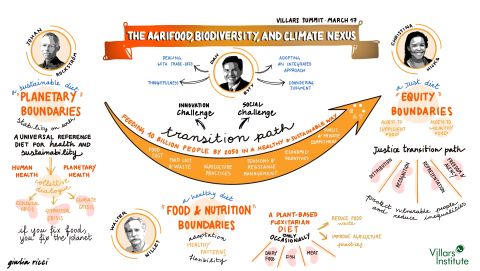Ancient water systems and deep subsurface microbial ecosystems remain at the frontier of our knowledge. This anticipatory briefing aimed to explore the latest research unraveling the mysteries of life deep within the Earth and consider how these findings could influence our understanding of biology, evolution, and the search for extraterrestrial life in the next five, 10, and 25 years.
The following is the rapporteur report of an expert discussion held during the 2024 GESDA Summit. The author is a Villars Fellow.
Ideas from the Speakers
Where did life originate? Scientists have pondered this question for years. It is now well known that the first single-celled organisms emerged from water near thermal vents; however, it was previously assumed that they lived in the ocean. The speaker’s research questions these assumptions and raises the possibility that the first life did not originate from the sea but from underground.
Background
The microbiology found on the surface of our planet is well known and well studied. Still, according to the speaker, we have barely begun to explore the microbiology under the surface. In fact, until the 1980s, we did not think there was any microbiology there at all. It was believed that depths greater than 100 meters below the surface were sterile, as all microbial life was thought to depend on photosynthesis for survival. However, in 1977, living organisms were discovered at the bottom of the ocean and, later, life was also found kilometers below Earth’s surface, including in water-filled cracks within rocks in caves as well as in mines and deep aquifers. This revealed the existence of chemosynthesis, where plants get energy from chemical reactions instead of the sun, explaining how plants could live in these extreme environments. We also discovered that underground water is much deeper than initially thought, deeper than the 100-meter mark. According to the expert, as much as 40% of Earth’s water may be trapped under the surface, and some water deep within the planet could be billions of years old. This raises the question of whether life could have originated from a crack in a cave or deep within the Earth. She noted that deep-sea divers in the Arctic found organisms that may represent a genetic link between single-celled life and more complex organisms. She also discussed the presence of natural radiation deep within the Earth, which plays a key role in producing hydrogen molecules that some underground organisms use as an energy source. More information is emerging about how organisms evolved to survive deep underground conditions by feeding on hydrogen molecules produced through natural radiation. This new knowledge opens up many possibilities for science.
In Five Years
Regarding the near term, the speaker discussed how human activities are rapidly altering the subsurface through extraction and injection. As our demand for resources grows, we are increasingly extracting water, critical minerals, and energy, which can disrupt the life below. We are also introducing harmful chemicals into the subsurface, both unintentionally, such as through groundwater contamination, and intentionally, by injecting toxic waste or storing chemicals like hydrogen and carbon underground. At the same time, we are discovering how subsurface life can benefit humans, particularly in the context of sustainability. Microorganisms naturally play a role in breaking down toxic chemicals that enter the environment, including those released into the atmosphere that later seep into the ground through the water cycle. However, the speaker warned that within the next five years, we must also consider how subsurface life could work against us, for example by interfering with natural carbon storage systems and altering the chemical balance of underground reservoirs.
In 10 Years
The speaker noted that over the next 10 years, our growing knowledge of subsurface life on Earth could have major implications for space exploration as discoveries on Earth affect our understanding of life on other planets. Knowing that not all organisms rely on photosynthesis means we are no longer looking solely for oxygen as a sign of life on other planets. Instead, we are exploring how life might exist on planets with atmospheres very different from our own. This research has led to greater attention on preventing contamination, both of Earth by bringing in asteroid samples and of other planets through the spacecraft we send to explore them.
In 25 Years
The speaker explained how our increasing demand for electric vehicles is driving an increasing demand for minerals. And as the human population grows, so does our need for groundwater and oil, two resources whose extraction affects subsurface life. We are not yet certain how our actions impact subsurface life today, but we must still be very careful when interfering with our underground in order to minimize those effects. Within the next 25 years, international organizations must implement policies concerning the subsurface, tying back to one of GESDA’s major goals: to create policy for science that does not yet exist. We have treaties for space and the sea, so why not for the subsurface?
Insights from the Audience
When asked whether she worries about long-term nuclear waste storage, the speaker answered that there is currently little policy addressing the issue. However, she emphasized that in places where storage has successfully been implemented, it is supported by years of research ensuring it will not affect water sources.
Another question asked how we can protect ourselves from ancient life while continuing to explore and research subsurface organisms. The expert explained that this must be done with great care to protect ourselves and the scientific results. Samples must not be contaminated, so it is a controlled and precise process. However, she reassured the audience that the risk to humans is low, as we likely came from similar forms of life. The procedure includes scanning for pathogens but, so far, none have been found. In fact, many of these organisms are similar to those already living in our own digestive systems.
To conclude, recent research on subsurface life reshapes our understanding of life’s origins and its role in Earth’s ecosystems. As human activities impact underground environments, protecting these microbial communities is critical. Developing policies to safeguard the subsurface will be essential in the years ahead.








